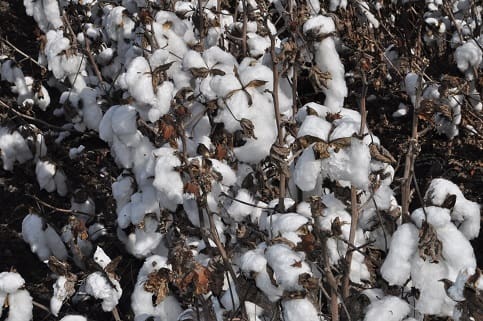 COTTON production in the Murrumbidgee and Murray valleys of southern New South Wales has hit a record 800,000 bales, with 53 new growers joining the region’s existing cohort of 110 to grow a record area of 72,000 hectares.
COTTON production in the Murrumbidgee and Murray valleys of southern New South Wales has hit a record 800,000 bales, with 53 new growers joining the region’s existing cohort of 110 to grow a record area of 72,000 hectares.
The average yield for this all-irrigated area was around 11 bales per hectare, with up to 13b/ha in places, and as little as 9b/ha in others.
The valleys are serviced by three gins, RivCott at Carrathool, Auscott at Hay, and Southern Cotton at Whitton.
RivCott general manager, Sam Buster, said the RivCott operation would be ginning until November.
“There are plenty of new growers sending cotton to the gins this year,” Mr Buster said, adding that the shift had been due largely to the high cost of irrigation water.
“When the price of water goes up, the margin is worse on rice, and that makes cotton look better, especially when the price of cotton is high.”
Monsanto regional business manager for southern NSW, Luke Sampson, said production and area were up around 50 per cent on last year’s figures, with the Murrumbidgee Valley planting 67,500ha, and the Murray 4500ha.
“Some of these operators mightn’t have been set up for row crops, so they’ve had a big capital cost in earthworks and machinery to get ready for cotton. The new growers are smaller family farms, traditionally rice growers that have been looking at cotton and transitioning for some time,” Mr Sampson said.
Districts including Benerembah, Coleambally, Leeton and Murrami have seen a number irrigators switch from rice to cotton this year.
“Rice uses roughly 30 per cent more water per hectare than cotton, and the areas that have converted have been high water-use areas.
Mr Sampson said irrigators who were using 13-14 megalitres/ha for rice were likely to use 9-10Ml/ha for cotton.
Dry clouds prospects
Strong prices are encouraging growers to plant cotton, but Mr Sampson said the outlook for irrigation water over the summer months could well restrict next season’s planting area.
“There are concerns about water availability for next year’s crop.
“There will be less carryover of allocation than the 30 per cent we saw last year, and the cotton area could reduce next season.”
How much is planted in the southern NSW valleys would now depend on irrigation allocations administered by the NSW Government.
“I still think the area could increase if there was full water available going into planting, and growers had supplementary water on farm that they’d been able to pump when the river got to a high enough level.”
Southern picking nears end
Auscott farm manager at Hay, Bill Back, said ideal picking conditions meant more than 95 per cent of the crop had now been taken off in the south.
“Dry harvest conditions have allowed the crop to come off quickly with very few colour discounts in an area that can be prone to discounts on quality,” he said.
“It has been an average year for most with yields of 11-13b/ha. Some people hoped for more, but I don’t think most people would be disappointed with the way the season has ended up.”
Big year on the Macquarie
Further north in central NSW, the Macquarie Valley has had one of its best cotton seasons on record.
Muldoon Pratten Consulting senior agronomist, Ryan Pratten, said while there was still a lot of cotton to be ginned, Macquarie Valley producers had been very happy with the results of ginning so far.
“It has been a nice growing season. It got off to a nice start with warm weather. The crop got to first square reasonably early,” he said.
“There wasn’t exceptionally high mirid pressure early so it retained a lot of good, early fruit. I think that is where a lot of the high yielding fields came from. We didn’t get the extreme heat we had the season before.”
Mr Pratten said the Valley average was looking like it could be around 14b/ha.
“The yields have been consistently good throughout the valley. Although there are weaker fields here and there, overall the fields that have had some tough going have come through and yielded well,” he said.
“The average is high because there is not the big range of yields. Everyone seems to have enjoyed a good season.”
Mr Pratten said water usage this season wasn’t any higher than expected and there was some water being carried through, which was a positive for the coming season.
“With the high cotton prices and the momentum from high yields, a lot of water is going to be dedicated to cotton. At this stage we are not expecting any allocation for the new season, so it will all be grown on carryover water and bore water,” he said.
Namoi/Gwydir valleys above average
In the Namoi/Gwydir valleys of northern NSW, B&W Rural agronomist, Ben Dawson, said the irrigated crops this season had been above average, “not record breakers but definitely good results”.
“Growers generally had enough water to finish crops off. It was a low insect year. Temperatures weren’t quite as bad (hot) as the previous year,” he said.
“Dryland was all over the shop. Early crops struggled, but anything planted late has picked up. Yields have been adequate, but not spectacular.
“The issue is that, looking forward as far as water availability is concerned in the Namoi and Gwydir, there is zero allocation, so we are looking at a much-reduced irrigated cotton planting this year.”
Mixed bag in southern Queensland
Cotton crops on the Darling Downs were a mixed bag with average yields for irrigated crops, and well below average for dryland, except where individual crops were under storm rains.
Around St George the yields were slightly above average where people had full water, and in the Border Rivers region through the Macintyre Valley production was average with crops looking good, but not yielding as well as expected.
Early v late plant in Central Queensland
In Central Queensland, there are still a few late crops planted in late December that are yet to come off, but most have had defoliant applied and will be picked in the next few weeks.
Spackman Iker Ag Consulting director, Jamie Iker, said the early crop in CQ had been very good this year, while the later crop had been more variable.
“There were some really excellent yields with upwards of 10b/ha and some of the early crops upwards of 12b/ha. The quality was good as well,” he said.
“Some of the later crops started off as low as 5-6b/ha in isolated cases, while some were grown out longer and got up to 10-11b/ha.
“There were some dryland crops in CQ and some good yields. A lot were 2.5b/ha and some could be 5b/ha or more.”
Next season plantings likely to drop
Cotton Australia CEO, Adam Kay, said with picking of this season’s crop almost completed, the industry was on track to produce about 4.6 million bales, or over 1 million tonnes of fibre.
Looking ahead to next season, Mr Kay said cotton prices were particularly attractive, but plantings were likely to be significantly down due to depleted water storages.
“The price has been as high as $650/b for the coming season and even the season after. They are really solid prices. The only negative is a lot of growers haven’t got the water they would like for a full plant, so they can’t really forward sell at those prices because they haven’t got the water,” he said.
“At this stage with the current water we think there could be a crop of around 2.2 million bales, 50 per cent down on last year. We are just hoping for some decent inflows.
“The other thing that could happen is there is a lot of winter crop country that hasn’t gone in. In the northern areas they are hitting the (last available) date for planting cereals, so they will be thinking about putting some of that country to summer crops, especially if they get rain in August. So, sorghum and dryland cotton are on a lot of people’s minds.”
Grain Central: Get our free daily cropping news straight to your inbox – Click here






HAVE YOUR SAY